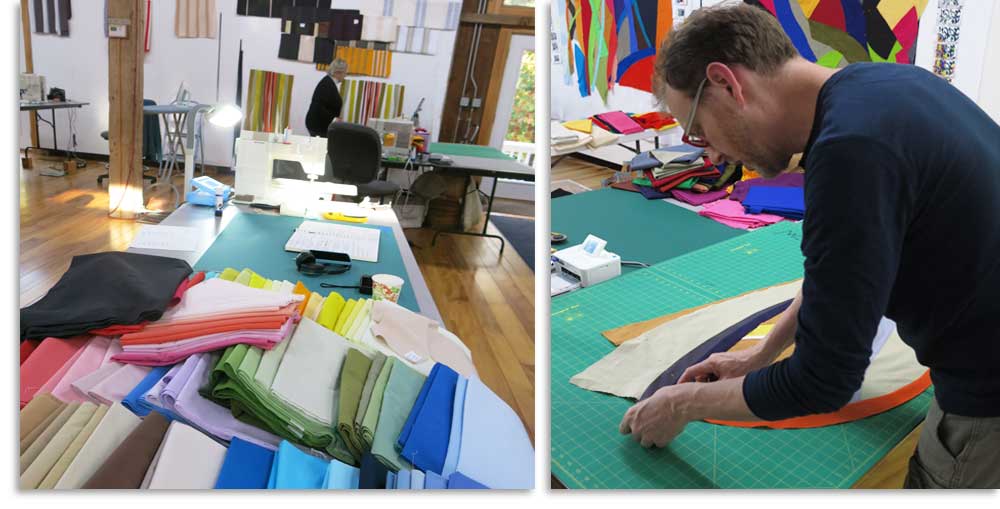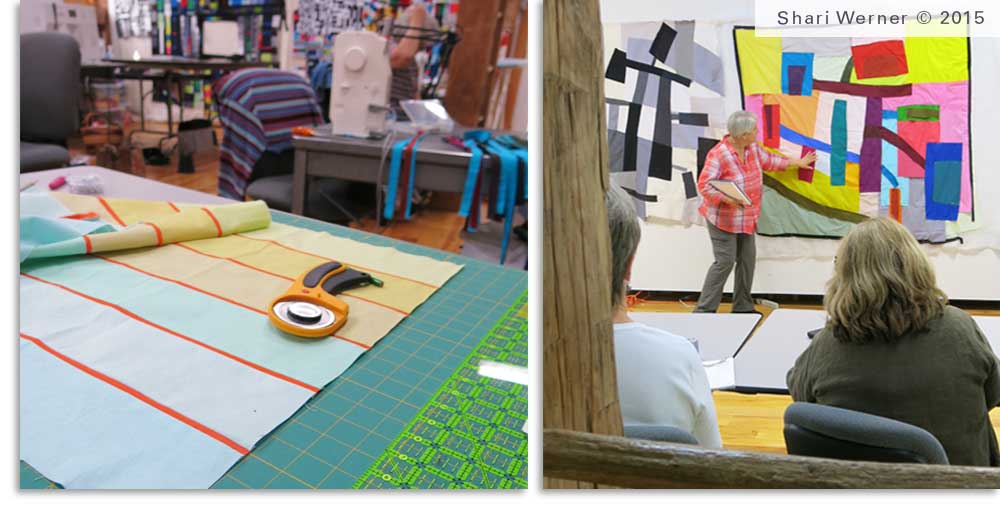STRIP-PIECING & RESTRUCTURING: Part II
• Length: 5 days• Level: Beginning to Intermediate
• Prerequisite: Good machine-sewing skills
• Sewing machine used
Note: These design exercises are not the same as those in Strip-Piecing & Restructuring: Part I.
DESCRIPTION
Strip-piecing is defined as a way of creating a “fabric vocabulary” out of existing fabrics that have been cut selvage to selvage. It is an invaluable way to learn more about color, value usage, proportions, line and shape in a very fluid manner.
• STRIP-PIECING: To start out, in PART II, students will be given new design exercises that outline how to create specific and often more complex fabric vocabularies (known as strip-pieced fabrics). In creating these brand new fabric vocabularies, students will develop the muscle memory needed to cut free-hand quickly and fluidly a large variety of widths of colors.
• These New Design Exercises will encourage:
- THE EXPLORATION OF LINE
- THE EXPLORATION OF WIDER WIDTHS OF SHAPE
- THE EXPLORATION OF A WIDER USE OF VALUE
- THE EXPLORATION OF A WIDER USE OF FLAT COLORS
***As students become more efficient machine-piecers, they will use the resulting strip-pieced fabrics in restructuring to explore more advanced figure/ground composition.
• RESTRUCTURING: The next new design exercises will push students to cut across and restructure strip-pieced fabrics in an even more improvisational manner to create ever-more complex structures. Students will experiment with all sorts of cross-cuts that create new SHAPES and LINES (ELEMENTS) out of their already strip-pieced fabrics. These will be sewn together and then recut. These elements will be used in restructuring which means combining shapes and lines into new figures or configurations. Groups of configurations will be strung together or combined with other sewn structures to create increasingly complex compositions. As a result, students will become more experienced in construction and engineering techniques and more comfortable with generating ideas that promote excellent figure/ground composition.
• Color - and the values of color from light to dark (5 steps in value)—-will be emphasized in all exercises so a great selection of fabrics based on these values must be brought to this workshop. Students will be working in SOLID COLORS and graphic prints, plaids and stripes. Do not bring florals or other types of prints.
Students must read the fabric list and supply list and come prepared. These lists are accurate!!! Note regarding the fabric lists:
- Concentrate on collecting DARKS and MEDIUM DARKS!
- Concentrate on collecting LIGHTS and MEDIUM LIGHTS!
- Concentrate on collecting BRIGHTS!
- Concentrate on collecting FLATS and GLOWINGS!
- Concentrate on collecting PLAIDS!
- Concentrate on collecting STRIPES!
- Concentrate on collecting GRAPHIC GEOMETRICS!
If students want to learn to work more effectively, more efficiently from “instincts” and “intuition” they must come with an open mind and no agendas, ready for growth and for risk-taking!
PRESENTATION
- Optional but important: Each student should come prepared with a digital presentation/laptop or 3-6 actual quilts and be prepared to make a short (3-5 minutes maximum) but articulate presentation about their work including future goals. The Crow Timber Frame Barn provides use of a digital projector connected to a laptop. This helps me and all the other students to know where you are in your work at this time. Please bring new work since the last time I saw your work.
SUPPLIES
- Sewing Machine
- Needles/Bobbins
- Digital Camera/Printer (Canon SELPHY printer recommended)/Paper
- Scissors/Thread/Rulers
- Swing Arm Lamp
- 24” x 36” Cutting Mat
- 7’ x 7’ Batting/Flannel (White) on which to pin work (optional)
- Extra Large Rotary Cutter and Blades
- Iron/Iron Cleaner (optional as Barn has irons)
- Ball-Head Pins (very fine and regular size)
- Small Water Spray Bottle for Ironing
- Glue to Adhere Snapshots into Sketchbook
- Multiple Outlet Power Strip/Adaptors/Heavy Duty Extension Cords
- Sketchbook/Pens/Other Supplies You Want
- Packing Tape if shipping boxes (plus return labels)
Optional Books:
- CROSSROADS, 2007, Breckling Press (catalog from one of Nancy’s exhibitions) - signed/dated editions available at the Crow Timber Frame Barn
- NANCY CROW, 2006, Breckling Press (book covering Nancy's work from 1989-2005) - signed/dated editions available at the Crow Timber Frame Barn
- NANCY CROW, MONO-PRINTS: SELF-PORTRAITS: FOCUS, 2012 - signed/dated editions available at the Crow Timber Frame Barn
- COLOR IMPROVISATIONS 2 & CIRCULAR ABSTRACTIONS: BULL’S EYES QUILTS, 2016, (books from two exhibitions curated by Nancy) - signed/dated editions available at the Crow Timber Frame Barn
Unfortunately, the following titles are out of print, but your local library may have them or order on Amazon.com.
- GRADATIONS: FROM THE STUDIO OF NANCY CROW, Quilt House Publishing
- NANCY CROW: WORK IN TRANSITION, American Quilters’ Society
- NANCY CROW: QUILTS AND INFLUENCES, American Quilters’ Society
- NANCY CROW: IMPROVISATIONAL QUILTS, C&T Publishing
Fabrics:
6 yards or more each of:
- SOLID BLACK and SOLID WHITE
2-3 yards each of:
- BRIGHT COLORS - bright red, orange, acid yellow, lime, turquoise, blue, apple green, pink, lavender, etc. (very saturated bright colors … the brightest color that are never darker than medium value)
1 yard or more:
- GRAPHIC PRINTS (graphic prints means very simple prints with patterns in rows or columns)
- PLAIDS
- STRIPES
- Light values
- Medium light values
- Medium values
- Medium dark values
- Dark values
2-3 yards each of: (bring 5 steps in value)
- GRAYS (wide range in light, medium light, medium, medium dark, dark)
1 yard or more of each color:
- SOLID OPAQUE COLORS (wide range in light, medium light, medium, medium dark, dark values so you can be free to work) - reds, pinks, blues, teals, greens, limes, violets, browns, yellows, golds, oranges, purples, maroons, turquoises, rusts, etc.
- TANS (wide range in light, medium light, medium, medium dark, dark)
- OFF-WHITES (warm white, cold white, cream)
- Bring BOTH the GLOWING and the FLAT versions of as many of these colors as possible.
- Please wash and shrink all fabrics! No need to iron though if you fold at end of drying cycle!
- We will use everything listed above so do not decide to leave anything out.
- DO NOT BRING FAT QUARTERS.
- Bring enough variety so you are not hamstrung!
NOTES REGARDING FABRIC SUPPLY LIST
Yes, the rumor is true!!! Yes, I do ask that each student bring lots of fabrics. My personal theory embraces the belief that one will be freer to be creative if one has many fabric choices available in class. After 35+ years of teaching, I consider each class I teach to be on a graduate level and therefore I expect students to arrive prepared with all necessary supplies. In that regard, I have outlined those fabrics we will use in this class. For some students, my fabric supply list will seem overwhelming in quantity and variety, while for other students, the selection they bring will never be good enough.
About solid colors - the more shades you have to work with, the more you will learn about how to work with color. Color is Joyous!!! Color does not cause pain!!! Take DELIGHT in color!!! Working in color does not mean only using BOLD colors or HOT colors; working in color means learning to be versatile in all types of colors.
I caution you to not bring mostly middle value solids, rather bring a wide variety, including these 5 steps in value:
- Light values
- Medium light values
- Medium values
- Medium dark values
- Dark values
Any color can be GLOWING or FLAT:
• GLOWING tones are any colors mixed with yellow and which have a glow coming off the surface.
• FLAT tones are those colors mixed with black and which emit a dullness, energy draining very subdued nature.
Many students arrive with their own hand-dyed solids or stacks they have purchased from other dyers. By all means, bring hand-dyed if you want but they need to be opaque and not have multiple values swimming across them ... meaning white or light splotches on dark colors.
However, flat solids (dyed commercially) are equally acceptable.
I usually work with flat colors or my own subtly dyed flat colors. My own palette includes approximately 500 shades.
I cannot specifically tell you to only bring 1 yard cuts of each color because I know we will be using at least a yard or more of some to many colors depending on each student’s color preferences. If you bring a yard of each – say 5 blues, 5 reds, 5 yellows, 5 greens, etc., but one each in light values, medium light values, medium values, medium dark values, & dark values, that would be better than not having enough. So bring 1 yard of as many colors as you can afford and shorter lengths for the rest.



